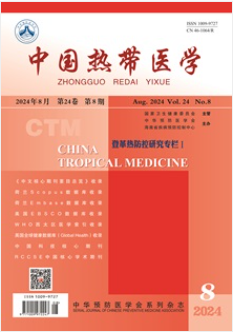Evaluation of control effect of implement effective control for intestinal nematode disease in Nanjing
引用次数: 0
Abstract
Objective To evaluate the control effect of effective control for intestinal nematode disease, and to analyze the dynamic change of epidemic trend, we provide basis for adjusting control strategy of intestinal nematode disease. Methods The data of control strategies in Nanjing from 2001 to 2019 were analyzed, including monitoring data of intestinal nematode disease, drug deworming, health education and rural toilet improvement. Results From 2001 to 2019, 191 172 person-times of residents were surveyed fecal examination in Nanjing City, and 2 596 person-times of residents were detected with intestinal nematode infections, with annual average infection rate 1.36%. The positive rate of human intestinal nematode infections showed a significantly declining trend in total ( P <0.01). In Nanjing, intestinal nematode infections were mainly caused by ascaris (0.90%, 1 724 cases), hookworm (0.30%, 564 cases), pinworm (0.09%, 179 cases) and trichuris (0.07%, 129 cases). Among them, 2 345 cases (96.98%) had mild infection. In 2001, the infection rate was the highest (7.00%), while in 2018 and 2019, the infection rate was the lowest (both 0.01%). The difference of infection rate in each year was statistically significant ( P <0.01). 114 940 person-times of children under 12 years old were surveyed for the special surveillance of pinworm in Nanjing, and 500 cases were detected with positive infection. Moreover, the positive rate showed a significantly decreasing trend in total ( P <0.01). At the end of 2019, 9 237.5 million person-times have been treated with medicine, the awareness rate of intestinal nematode control among the population in Nanjing reached more than 90%, the penetration rate of harmless toilets was 99.99%. Conclusion The effective control of intestinal nematode disease in Nanjing has achieved remarkable results, however, the surveillance network of intestinal nematode disease still should be improved, and health education in key population groups should be strengthened, in order to adjust control strategies in time, and effectively consolidate the effectiveness of the control of intestinal nematode disease. 摘要:目的 评价有效控制肠道线虫病项目的防治效果,分析流行趋势的动态变化,为调整肠道线虫病防控策略 提供依据。 方法 对2001—2019年南京市肠道线虫病监测数据、以及实施驱虫服药、健康教育、农村改厕等防治策略 资料进行统计分析。 结果 2001—2019年,南京市共粪检191 172人次,检出肠道线虫阳性感染2 596人次,年平均感 染率为1.36%,人群肠道线虫感染率逐年下降趋势( P <0.01)。南京市肠道线虫感染以蛔虫、钩虫、蛲虫、鞭虫为主,且以 轻度感染为主,共计2 345 例(占96.98%),感染人数分别为1 724例、564例、179例和129例,感染率分别为0.90%、0.30%,0.09%和0.07%。以2001年的人群感染率最髙,为7.00%,2018年和2019年的感染率最低,均为0.01%,各年份人 群感染率差异有统计学意义( P <0.01)。南京市儿童蛲虫病专项监测累计检査儿童114 940人次,阳性感染者500人次。儿童蛲虫感染率亦呈现逐年下降趋势( P <0.01)。截至2019年12月,南京市已累计服药驱虫923 750万人次,人群肠道 线虫病卫生知识知晓率大于90%,无害化卫生户厕普及率为99.99%。 结论 南京市有效控制肠道线虫病防治项目取 得显著效果,但仍需不断完善肠道线虫病的监测网络,加强重点人群健康教育,适时调整防控策略,有效巩固肠道线虫 病的防治成效。南京市实施肠道线虫病有效防治效果评价
目的评价有效控制肠道线虫病的控制效果,分析肠道线虫病流行趋势的动态变化,为调整肠道线虫病的控制策略提供依据。方法对南京市2001 - 2019年肠道线虫病监测、药物驱虫、健康教育、农村厕所改善等防治策略数据进行分析。结果2001 - 2019年,南京市共开展居民粪便检查191 172人次,检出肠道线虫感染2 596人次,年平均感染率为1.36%。人肠道线虫感染率总体呈显著下降趋势(P <0.01)。南京地区肠道线虫感染主要病原为蛔虫(1 724例,占0.90%)、钩虫(564例,占0.30%)、蛲虫(179例,占0.09%)和毛线虫(129例,占0.07%)。其中轻度感染2 345例,占96.98%。2001年感染率最高(7.00%),2018年和2019年感染率最低(均为0.01%)。各年感染率差异有统计学意义(P <0.01)。调查南京市12岁以下儿童蛲虫专项监测114 940人次,检出阳性感染病例500例。总阳性率呈显著下降趋势(P <0.01)。截至2019年底,全市累计用药92.375亿人次,全市人口肠道线虫防治知晓率达90%以上,无害化厕所普及率达99.99%。结论南京市肠道线虫病的有效防治取得了显著成效,但仍需完善肠道线虫病监测网络,加强重点人群的健康教育,及时调整防治策略,有效巩固肠道线虫病的防治效果。摘要:目的 评价有效控制肠道线虫病项目的防治效果,分析流行趋势的动态变化,为调整肠道线虫病防控策略 提供依据。 方法 对2001—2019年南京市肠道线虫病监测数据、以及实施驱虫服药、健康教育、农村改厕等防治策略 资料进行统计分析。 结果2001 - 2019年,南京市共粪检191 172人次,检出肠道线虫阳性感染2 596人次,年平均感染率为1.36%,人群肠道线虫感染率逐年下降趋势(P < 0.01)。南京市肠道线虫感染以蛔虫,钩虫,蛲虫,鞭虫为主,且以轻度感染为主,共计345例(占96.98%),感染人数分别为724例,564例,179例和129例,感染率分别为0.90%,0.30%,0.09%和0.07%。以2001年的人群感染率最髙,为7.00%,2018年和2019年的感染率最低,均为0.01%,各年份人群感染率差异有统计学意义(P < 0.01)。南京市儿童蛲虫病专项监测累计检査儿童114 940人次,阳性感染者500人次。蛲(p <0.01)。截至2019年12月,南京市已累计服药驱虫923 750万人次,人群肠道线虫病卫生知识知晓率大于90%,无害化卫生户厕普及率为99.99%。结论 南京市有效控制肠道线虫病防治项目取 得显著效果,但仍需不断完善肠道线虫病的监测网络,加强重点人群健康教育,适时调整防控策略,有效巩固肠道线虫 病的防治成效。
本文章由计算机程序翻译,如有差异,请以英文原文为准。
求助全文
约1分钟内获得全文
求助全文
来源期刊
CiteScore
0.60
自引率
0.00%
发文量
13927
期刊介绍:
China Tropical Medicine, was approved by the Ministry of Science and Technology in 2001, is the only tropical medicine periodical under the charge of the National Health Commission of China. It’s organized by Hainan Provincial Center for Disease Prevention and Control, and Chinese Preventive Medicine Association.
The journal is indexed by the following database: Scopus database, Embase database, EBSCO Database, The Western Pacific Region index medicus (WPRIM), American Chemical Abstracts (CA), International Centre for Agricultural and Biological Sciences Research Database (CABI), Global Health Database, Database of the Ulrich's Periodicals Directory, China Science and Technology Core Journals, China Core Journals (Selection) Database, Database of Chinese Biomedical Literature, Comprehensive Evaluation Database of Chinese Academic Journals, CAJCD Code of Conduct Excellent Journal, Database of Chinese SCI-Tech Periodicals, China Journal Full Text Database.

 求助内容:
求助内容: 应助结果提醒方式:
应助结果提醒方式:


